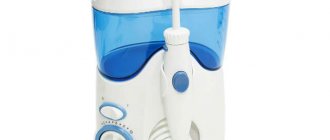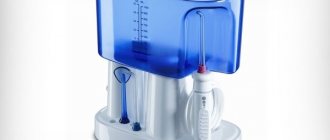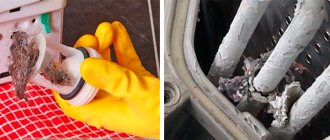6900
While wearing braces, special attention should be paid to the quality of oral hygiene, since the design makes it very difficult to clean the teeth. For this, not only special brushes are used, but also other devices that increase cleaning efficiency.
Such devices include an irrigator, which removes bacterial plaque and food debris from teeth, braces and implants using a jet of water .
All about braces care
- How to care for braces after installation?
- Minimum contents of a braces care kit
- Basic rules for caring for teeth with braces
- What braces care products do orthodontists recommend using?
- Orthodontic wax and irrigator: additional elements of the standard set
- Features of caring for sapphire braces
The procedure for straightening teeth and correcting bite is considered one of the longest and most difficult in dental practice. The bracket system is quite expensive, and without regular maintenance it will require replacement before the end of its intended service life. That is why it is necessary to strictly adhere to hygiene rules and do not forget to clean your braces daily.
Of course, there is always a risk of physical damage to an expensive structure due to an impact, but much more often the consumption of “forbidden” food leads to deformation. Any sticky or hard foods should be completely excluded from the diet. Taffy, caramel and chewing gum are especially dangerous. Tiny particles can get behind structural elements and begin to attract the remains of other food. Over time, plaque forms behind the ligatures.
What else to pay attention to
You have decided on the desired functionality of the device, but several models from different companies have similar characteristics. Pay attention to additional criteria that will help you choose the appropriate option.
- Service center and service in your city. Irrigators break down due to voltage surges, low quality water and frequent use. Some models cannot be repaired. If such a device breaks before the end of the warranty period, you will be provided with a new one. If a breakdown occurs after the end of the warranty period, the irrigator will have to be thrown away. Well-known manufacturing companies have service centers in large cities and offer service for irrigators. It is better to check the availability of a service center in your city, because you pay for the delivery of a faulty device.
- Energy consumption. Like any other household appliance, a stationary oral irrigator has an energy consumption rating. It is better to choose a class A or B device to reduce electricity costs.
- Company manufacturer. Devices from well-known brands are more expensive, but have a long warranty period and recommendations from specialists. The quality of the model is also higher.
You should not buy an irrigator on the recommendation of a sales consultant in a household appliances store. It would be better to make an appointment with a hygienist or consult with your doctor. He is aware of the condition of your oral cavity and will tell you how to choose a device and attachments for it.
Choose an irrigator for implants or braces especially carefully. High-quality care of orthodontic structures, dentures and implants makes their use comfortable. Compared to other cleaning methods - brushes, special threads, foams - the irrigator wins. It saves your time and protects your oral health.
How to care for braces after installation?
A professional orthodontist must teach his patient how to properly clean the braces. Teeth under dirty metal structures can deteriorate very quickly, so it is necessary to pay attention to oral hygiene on a daily basis. Caring for braces after installation involves thoroughly removing plaque and (if possible) disinfecting metal elements. An electric toothbrush with special attachments will do the best job of cleaning orthodontic arches, rings and ligatures. Alternatively, you can purchase a regular brush with medium-hard artificial bristles.
First of all, you need to remove the removable rubber bands and thoroughly brush your teeth, then place the brush at an angle of 45 degrees to the jaw. The bristles should completely cover the ligature. You need to spend at least ten seconds on each tooth. In order to clean the braces from the inside of the jaw, you will need a special V-shaped single-tuft brush. After all the metal elements are perfectly clean, you need to take a special wax and lubricate all the places where the braces come into contact with the mucous membranes (including the interdental space). For greater convenience, you can use a special thin brush.
Minimum contents of a braces care kit
Careful oral hygiene is an integral part of caring for your braces. After installing an orthodontic device, you will have to brush your teeth not only in the morning and evening, but also after every meal. You will need a whole arsenal of accessories and special products in order to provide complete care for teeth with braces. The minimum required is:
- V-shaped toothbrush;
- toothpaste;
- waxed dental floss;
- floss toothpicks, or interdental brushes,
- monotuft brush;
- pocket mirror.
It is best to purchase a ready-made orthodontic kit. A braces care kit usually comes with a cosmetic bag or a small plastic box. This kit is very convenient to carry with you and can be used after every meal, even outside the home.
Why do you need dental brushes and how to use them?
If you take good care of your oral cavity, then you know what dental brushes are for.
This is an item that should be in the arsenal of every person striving for a beautiful smile. People who use them visit the dentist less often to treat tooth decay and remove tartar. However, the majority still brush their teeth only with a brush and toothpaste, and ignore all other oral hygiene devices. What is a dental brush
You can brush your teeth with a toothbrush only from three sides - front, back and chewing part. But there are also sides that a regular brush cannot clean. Food debris accumulates between the teeth, causing plaque to form, which, as you know, is an excellent environment for the development of bacteria. When bacteria enter a favorable environment, they begin to actively multiply.
Plaque is the result of bacterial activity; it causes caries, pulpitis, purulent inflammatory processes and other oral problems. And all because the space between the teeth is not cleaned properly. It is this problem that dental brushes help solve.
Their use is much more convenient than using dental floss. They are safer than toothpicks because they cannot damage tooth enamel or gums. In addition, during use, this instrument also massages the gums, stimulating blood circulation in them.
If you have braces to correct your bite, dentures or bridges, the quality of teeth cleaning is reduced. A brush for cleaning teeth will help to cope with this problem, so for people with braces it is simply necessary.
Of course, there are excellent devices for deep cleaning of teeth - irrigators, which clean the oral cavity with a water jet that is released under pressure. But a significant disadvantage of these devices is their high cost, so they are not available to everyone and are not at all common among the population. Compared to such a device, dental brushes are affordable for everyone and clean the interdental space no worse than these expensive devices.
In appearance, dental brushes resemble tools that are used to wash bottles. Only they are, of course, smaller in size and made of softer, safe material that meets all quality standards.
These devices are sold as a kit, which includes several attachments and holders. The attachments are usually removable, but there are also solid models. There are options made specifically for implants: to avoid scratching the surface, they are coated with a special coating.
Different types of models differ from each other in the density of the bristles, the size of the base and the material from which the rod is made. It can be metal or plastic. Manufacturers offer a large selection of holders for brushes; there are no general recommendations in this matter and everyone can choose a convenient option.
Basic rules for caring for teeth with braces
As mentioned above, proper care of the braces system begins with brushing your teeth. Using circular movements, it is necessary to clean each tooth from the outside and back. When using an electric toothbrush, it is strictly forbidden to press the head too hard against metal elements. This risks causing the bristles to break out and get stuck in the ligatures.
Next, you need to use a floss toothpick or a special brush to remove plaque from the interdental spaces. But to remove food debris directly from under the braces, waxed dental floss is suitable. To clean, you need to tear off about 30 centimeters of thread and carefully insert it under the staple. Then pull the thread under the rings and holes in the locks and make several cleaning movements. Repeat the procedure with each tooth. Next, you can begin to carry out the above-described care program directly for braces, after rinsing your mouth with salt water or a special solution.
Stationary irrigators
The stationary irrigator is intended for home use. It runs on mains power. For ease of use, it is advisable to place the device near an outlet. Such devices are distinguished by a high level of water pressure, durable housing, and a spacious tank. It is advisable to place the irrigator in the bathroom and use it immediately after brushing your teeth.
| Characteristics | Waterpik WP-100 | Revyline RL 300 | Waterpik WP-660 | Braun Oral-B OxyJet MD20 |
| Min. pressure, kPa | 35 | 140 | 220 | 150 |
| Max. pressure, kPa | 650 | 860 | 690 | 600 |
| Tank volume, ml | 600 | 800 | 690 | 600 |
| Pulse frequency | 1200 | 1200 | 1400 | 1200 |
| Number of modes | 10 | 10 | 10 | 5 |
| Wall mount | No | No | No | Yes |
| Power cord length, m. | 1,3 | 1,3 | 1,3 | 1,2 |
What braces care products do orthodontists recommend using?
As for toothpaste, it is better to give preference to one that contains fluoride and xylitol. You can also choose a mouthwash with a similar composition. Fluoride will help prevent tooth decay, and xylitol will protect against bacteria and germs. Also, xylitol-based products leave a pleasant feeling of coolness, which allows you to forget about the presence of iron braces in your mouth for a while.
As for home remedies, dentists recommend using plain salt water as a rinse. Rapa will quickly relieve pain, which often occurs in the first month after installation of the system, and will also destroy bacteria in the oral cavity. Salt water will help heal sores and cuts that may appear on the gums or the mucous membranes on the inside of the cheek. To prevent damage to mucous membranes, it is better to use professional braces care products.
Flow irrigators
The devices operate from the household water supply without requiring power. The supply hose must be connected to the tap through the installation block. This will ensure a flow of fluid with enough pressure to clean your mouth. Using conventional valves, you can regulate the temperature and pressure of the water. The flow irrigator is installed directly on the faucet. No special skills are required for its installation, just read the instructions. An important advantage of such a device is its independence from electricity, which allows you to save on electricity.
Orthodontic wax and irrigator: additional elements of the standard set
The use of orthodontic wax can significantly reduce the discomfort caused by metal braces.
Very often, protruding elements of the braces system scratch the delicate tissues of the oral cavity. Wax protects gums, inner lips and cheeks from sores and scratches. The wax is sold in small plastic boxes and has a structure similar to soft chewing gum. Using the product is quite simple: you need to tear off a little wax from the container, warm it in your palms, and then apply directly to the lock or bracket that is causing irritation. Don't worry that some of the wax will be accidentally swallowed, because dental products are non-toxic. Another optional, but very useful device designed to make caring for braces easier is an irrigator. This dental device is used to clean the spaces between braces and teeth. The irrigator acts as a small pump that directs a stream of water to the desired location.
Irrigator for braces and implants
In addition to the purposes already indicated, an irrigator, which provides teeth cleaning with water under pressure, is actively used for home cleaning of hard-to-reach surfaces of braces and implants. By and large, this device is necessary to control the hygienic situation when installing any dental structure, including dental crowns, ceramic veneers and lumineers.
In periodontal treatment, after the onset of remission, the irrigator washes out subgingival deposits from the gum pockets and interdental contact points, thereby improving microcirculation in the gums.
What toothbrushes should you buy to care for braces?
For complete care, one v-shaped brush is not enough. In order to be sure that the teeth under the braces system are perfectly cleaned, you need to have several more types of brushes in your arsenal.
Interdental.
This type is used to clean spaces between brackets as well as areas under metal arches. Interdental brushes are available in different sizes, so they can also be used for deep cleaning of interdental spaces.
Mono-beam.
The mono-beam brush has a curved shape, thanks to which it can reach even the most difficult to reach places. This type of brush is intended for caring for braces, not teeth. Even the smallest clasps and ligatures will be perfectly clean with daily use of mono-tuft brushes.
It is worth knowing that any type of brush will wear out several times faster. This is due to the fact that when cleaning a metal system, the bristles can be pulled out. Therefore, you will have to change all care accessories much more often than recommended on the package.
Mechanical irrigators
The most economical device, because it works from the power of human hands. The impact is carried out using a piston system. When squeezed by hand, pressure is created sufficient for the flow of liquid. This device is more suitable for traveling, since it is better to use a stationary irrigator at home. The mechanical device does not provide sufficient pressure, so it will not be possible to perform regular cleaning with it. This type of irrigator has the lowest price.
Features of caring for sapphire braces
Adult patients prefer polymer materials to metal that is too visible. Sapphire braces are transparent, lightweight and ultra-thin, which allows you to avoid drawing unnecessary attention to your smile. In general, caring for sapphire braces is practically no different from the above rules. However, orthodontists recommend remembering several important nuances. Firstly, it is forbidden to smoke, drink tea and coffee in large quantities. Violating this rule will result in expensive transparent braces acquiring a yellowish tint. You will also have to rinse your mouth not twice a day, but after each meal. After all, any dirt stuck behind the ligatures will be visible to others.
We must not forget that the polymer material is quite fragile. Orthodontists recommend purchasing a special protective mouthguard, which must be worn whenever active sports are planned.
If you adhere to all the above rules, then you don’t have to worry about the condition of your teeth after removing braces.
How to choose an irrigator: useful tips
A standard irrigator consists of the following components: a handle holder, a water tank with a lid, a battery, a charger and a set of nozzles. For ease of use, the device is equipped with control buttons: removing/fixing the tip, turning it on/off, adjusting the pressure.
Stationary and compact irrigator
There are two types of irrigators: stationary, which are large in size and connected to power via an outlet, and compact - they are small in size and run on batteries or a rechargeable battery. When choosing a device, it is recommended to give preference to the second type - it can be used even where there is no outlet, you do not depend on the length of the wire, and a small water tank is enough for one teeth cleaning procedure. In addition, you can always take it with you on a business trip or travel.
Battery type
Modern irrigators operate either from the mains or from a battery. It is better if the device is equipped not with batteries, but with a rechargeable battery - in this case, you can quickly recharge it. As a rule, it takes several hours to fully charge, so as soon as the device signals that there is no power, try to connect it to power overnight - this way you won’t miss another hygiene routine.
Device weight
It is best to choose devices that are light in weight - when performing hygiene, it will be easy and convenient to hold in your hands.
Number of nozzles
Even the most inexpensive models of irrigators have at least 2 nozzles - as a rule, they do not fail, so several family members can use the device at once. This is a significant plus. Some devices even come with colored attachments, allowing you to choose your own color.
Number of modes
There should be at least two of them: weak and strong - in this case you can choose the most optimal one for yourself, depending on the condition of your gums. Otherwise, too little pressure may not be effective; too much pressure will result in injury to the mucous membranes. In addition, if you have braces, it is recommended to use low pressure, which will allow you to clean hard-to-reach spaces, but will not lead to the braces coming off.
Some models of irrigators have special nasal attachments. They are effectively used to rinse the nasal cavity for rhinitis and sinusitis.











